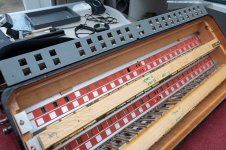I have a bit mixed feelings about the Hohner Solist MB2. It is a nice entry-level convertor accordion, but not more than that. Hohner really tried to save on the production cost as much as possible (they tend to always do that except on the Gola), and it shows.

You can see that the plastic register sliders are not "covered" (so they can easily fall out), and the plastic base of the reed block forms both the cover and seal. There is no leather or other seal between the reed blocks and the soundbar... and you can see the reed blocks are made of cheap wood.

The bass side consists of 3 rows of melody bass and 5 rows of standard bass. You see what looks like two register switches, but they actually are not registers but are an octave coupler. (They are harder to press because they do more work than a register switch.)
The bass side actually has only 58 reed plates, for 58 notes (3 row C-system). But the "registers" sound like there is a choice between L and LM. However, what happens is that the notes of one octave higher are just "coupled in" to give the LM sound, and in the highest octave you only get L because there is no higher octave to couple in. It's a clever trick to give you the illusion that the accordion has 58 notes in the melody bass in LM (which would require 116 reed plates), at half the cost.
When you say the price is "1600" I guess you mean US$ and I would not be willing to pay that much for a Solist MB2. Of course sale price is a matter of finding a compromise between the high value the vendor thinks the accordion has and the low value the prospective buyer is willing to pay.



